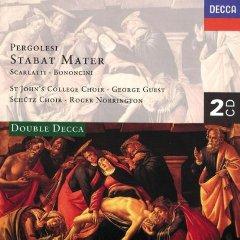Pergolesi, Scarlatti, Bononcini – Stabat Mater & other works [1995]
Pergolesi, Scarlatti, Bononcini – Stabat Mater & other works [1995]

CD 1: Giovanni Battista Pergolesi – Stabat Mater 1.1. Stabat Mater 4:10 2.2. Cujus animam 2:45 3.3. O quam tristis 2:24 4.4. Quae moerabat 2:45 5.5. Quis est homo 3:04 6.6. Vidit suum 4:23 7.7. Eia Mater 2:39 8.8. Fac ut ardeat 2:44 9. Sancta Mater 5:26 10.10. Fac ut portem 4:05 11.11. Inflammatus 2:35 12.12. Quando corpus – Amen 4:09 Giuseppe Domenico Scarlatti - Stabat Mater 13.Stabat mater dolorosa 3:14 14.Cujus animan gementem 5:19 15.Quis non posset contristari 4:19 16.Eja, mater, fons amoris 2:21 17.Sancta mater, istud agas 4:13 18.Fac me vere tecum flere 3:32 19.Inflammatus et accensus 9:04 Felicity Palmer – soprano (2,5,6,9,11,12) Alfreda Hodgson – contralto (4,7,9-12) Choir Of St. John's College, Cambridge (1-12) The Argo Chamber Orchestra / George Guest (1-12) Schütz Choir of London / Roger Norrington (13-19) CD 2: Alessandro Scarlatti (1660 - 1725) 1. O Magnum Mysterium 6:16 2.Domine, Refugium Factus es Nobis 4:14 Giovanni Battista Pergolesi - Magnificat 3.Magnificat 2:51 4.Et misericordia 1:44 5.Deposuit Potentes 1:48 6.Suscepit Israel 1:51 7.Sicut locutus est....Gloria 3:39 Antonio Lotti 8.Crucifixus (8vv) 3:39 Giovanni Battista Bononcini - Stabat Mater 9.Stabat mater dolorosa 3:22 10.O quam tristis 2:39 11.Quis est homo 2:38 12.Pro peccatis 3:57 13.Eja mater 4:31 14.Sancta mater 1:19 15.Fac me vere tecum flere 4:42 16.Juxta crucem tecum stare 2:09 17.Virgo virginum praeclara 1:38 18.Fac ut portem 1:58 19.Fac me plagis vulnerai 2:51 20.Fac me cruce custodiri 2:04 21.Quando corpus morietur 3:08 Antonio Caldara 22.Crucifixus 4:48 Felicity Palmer – soprano (2,5,6,9,11,12) Alfreda Hodgson – contralto (4,7,9-12) Choir Of St. John's College, Cambridge (1-12) The Argo Chamber Orchestra / George Guest (1-12) Charles Spinks – organ (1-2) Marilyn Sansom – cello (1-2) Keith Majoram – bass )1-2) Schütz Choir of London / Roger Norrington (1-2) Elizabeth Vaughan – soprano Janet Baker - contralto Ian Pertridge – tenor Christopher Keyte - bass The Choir of King's College, Cambridge Academy of St. Martin in the Fields - Leader Neville Marriner David Willcocks – conductor (3-7) Felicity Palmer – soprano Paul Esswood – countertenor Philip Langridge – tenor Christopher Keyte - bass Choir Of St. John's College, Cambridge Philomusica of London / George Guest (8-22)
The 'Stabat Mater' is a medieval poem describing the anguish of the Virgin Mary during the crucifixion written at the end of the 13th century by a Franciscan lay brother named Jacopone da Todi. It did not attract widespread attention from composers until the 18th century when Alessandro Scarlatti,his son Domenico, Vivaldi, Bononcini, Haydn and Pergolesi as well as many others set the poem to music. They were, no doubt, attracted to the emotional and dramatic nature of the poem, and most of the composers were commissioned by various individuals for non-liturgical devotions or concerts.
Alessandro Scarlatti's seems to be the earliest of the group. He scored it for soprano and alto voices(probably sung by a 'castrati' at that time), two violins and continuo. This setting was used frequently until Pergolesi's setting around 1735. Pergolesi modeled his composition after Scarlatti; for one thing both are scored for the same 2 voices and strings. Both divide the poem into a number of duets and solo arias. One difference between the two settings is that Pergolesi's is shorter and rather more concise. The very fine Schutz Choir of London under the direction of Roger Norrington renders this wonderful mucic wonderfully well!
It is not certain that Pergolesi actually wrote the 'Magnificat' on this disc, but it is a quality and richly imaginative work, nonetheless. Beautifully sung by the inimitable Choir of KIng's College (David Willcocks). Domenico's 'Stabat Mater' is set for 10 voices and organ and its mood is meditative clearly intended for liturgical use.(Schutz Choir)
Bononcini's 'Stabat Mater' was composed during his residence in Vienna. It is unique because of its harmonic and contrapuntal writing, in the choruses in particular and in the soprano aria 'O Quam Tristis'. It could have been written by Bach himself. St.John's College Choir gives this number skilled treatment. (George Guest).
The two 'Crucifixus' settings by Lotti and Caldara are both examples of the old-style composition as it had developed by the late Baroque; the harmonic and expressive techlniques of the new style were applied to the old polyphony, providing a highly emotional vehicle for a creative composer. Both works inspirationally sung by St. John's College Choir.
Opera and cantata were the 2 principal forms which Alessandro Scarlatti practised, but he also composed some superb motets, two of which are featured on this disc. 'O Magnum Mysterium' is for double choir eight-part counterpoint. (Schutz Choir) 'Domine refugium factus es nobis' is for five voices; it is in a style that relies much on sonorous harmony and counterpoint; in fact it has a grandeur that anticipates Handel. (Schutz Choir)
I think that it is interesting to note that there are varied groups and soloists performing on these disc, and all are quite good. Pergolesi's 'Stabat Mater' is disappointing to me because it does not have a countertenor performing the alto part; however, the contralto singer did an acceptable performance (St.John's College).
No matter what your personal preference may be as to soloists and/or particular choirs, it would indeed be difficult to not find something in the Early Music genre to enjoy on these two CD's. So go for it; it's a good price at this point in time. --- George Peabody, amaszon.com
download (mp3 @320 kbs):
yandex 4shared mega mediafire zalivalka cloudmailru uplea








